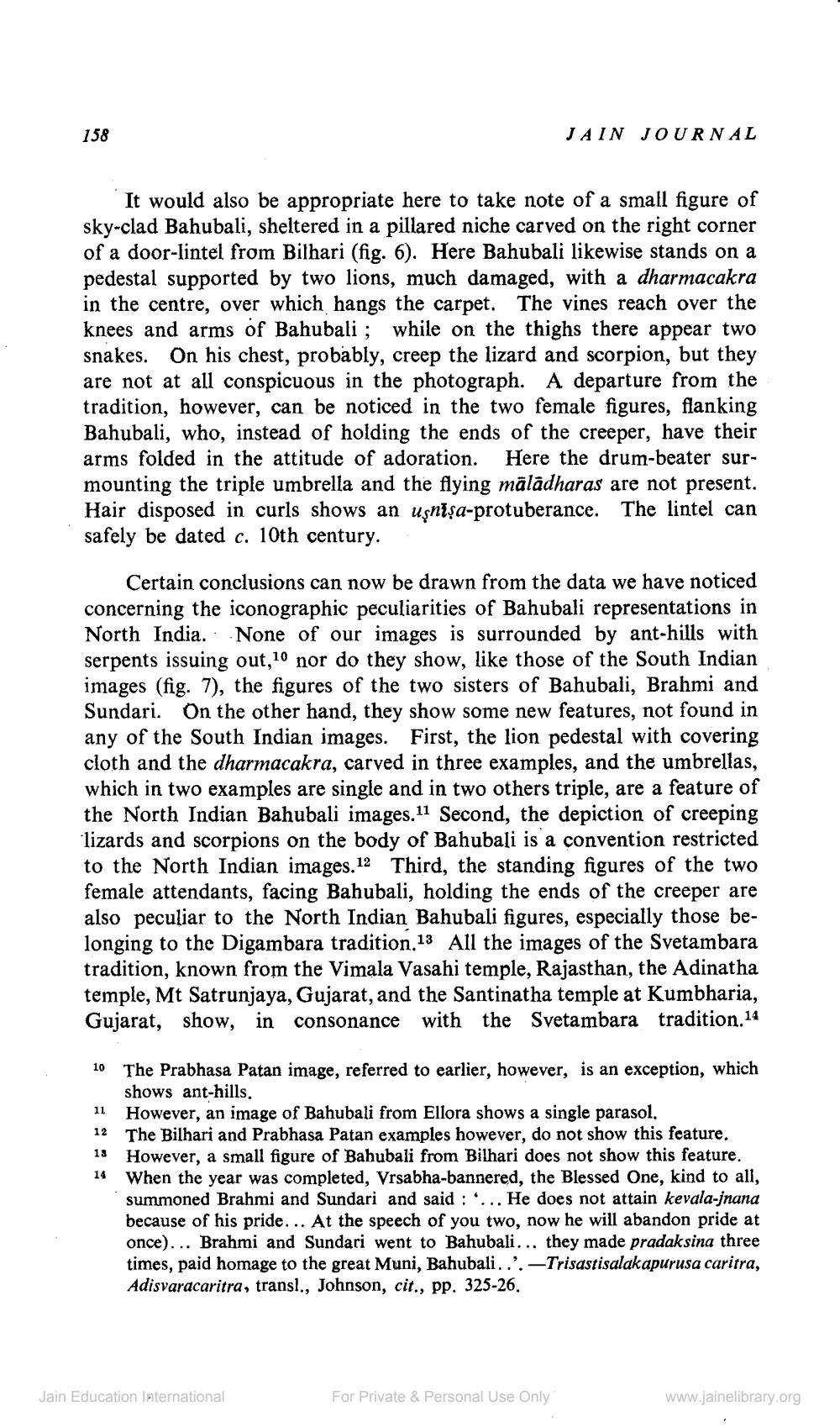________________
158
JAIN JOURNAL
It would also be appropriate here to take note of a small figure of sky-clad Bahubali, sheltered in a pillared niche carved on the right corner of a door-lintel from Bilhari (fig. 6). Here Bahubali likewise stands on a pedestal supported by two lions, much damaged, with a dharmacakra in the centre, over which hangs the carpet. The vines reach over the knees and arms of Bahubali ; while on the thighs there appear two snakes. On his chest, probably, creep the lizard and scorpion, but they are not at all conspicuous in the photograph. A departure from the tradition, however, can be noticed in the two female figures, flanking Bahubali, who, instead of holding the ends of the creeper, have their arms folded in the attitude of adoration. Here the drum-beater surmounting the triple umbrella and the flying māladharas are not present. Hair disposed in curls shows an uşnişa-protuberance. The lintel can safely be dated c. 10th century.
Certain conclusions can now be drawn from the data we have noticed concerning the iconographic peculiarities of Bahubali representations in North India. None of our images is surrounded by ant-hills with serpents issuing out, 10 nor do they show, like those of the South Indian images (fig. 7), the figures of the two sisters of Bahubali, Brahmi and
i. On the other hand, they show some new features, not found in any of the South Indian images. First, the lion pedestal with covering cloth and the dharmacakra, carved in three examples, and the umbrellas, which in two examples are single and in two others triple, are a feature of the North Indian Bahubali images. 11 Second, the depiction of creeping lizards and scorpions on the body of Bahubali is a convention restricted to the North Indian images. 12 Third, the standing figures of the two female attendants, facing Bahubali, holding the ends of the creeper are also peculiar to the North Indian Bahubali figures, especially those belonging to the Digambara tradition. 13 All the images of the Svetambara tradition, known from the Vimala Vasahi temple, Rajasthan, the Adinatha temple, Mt Satrunjaya, Gujarat, and the Santinatha temple at Kumbharia, Gujarat, show, in consonance with the Svetambara tradition.14
10 The Prabhasa Patan image, referred to earlier, however, is an exception, which
shows ant-hills. 11 However, an image of Bahubali from Ellora shows a single parasol, 12 The Bilhari and Prabhasa Patan examples however, do not show this feature. 18 However, a small figure of Bahubali from Bilhari does not show this feature.
When the year was completed, Vrsabha-bannered, the Blessed One, kind to all, summoned Brahmi and Sundari and said : '... He does not attain kevala-jnana because of his pride. .. At the speech of you two, now he will abandon pride at once). .. Brahmi and Sundari went to Bahubali... they made pradaksina three times, paid homage to the great Muni, Bahubali... - Trisastisalakapurusa caritra, Adisvaracaritra, transl., Johnson, cit., pp. 325-26.
imi and Seed, Vrsabhan Bilhari
Jain Education International
For Private & Personal Use Only
www.jainelibrary.org




